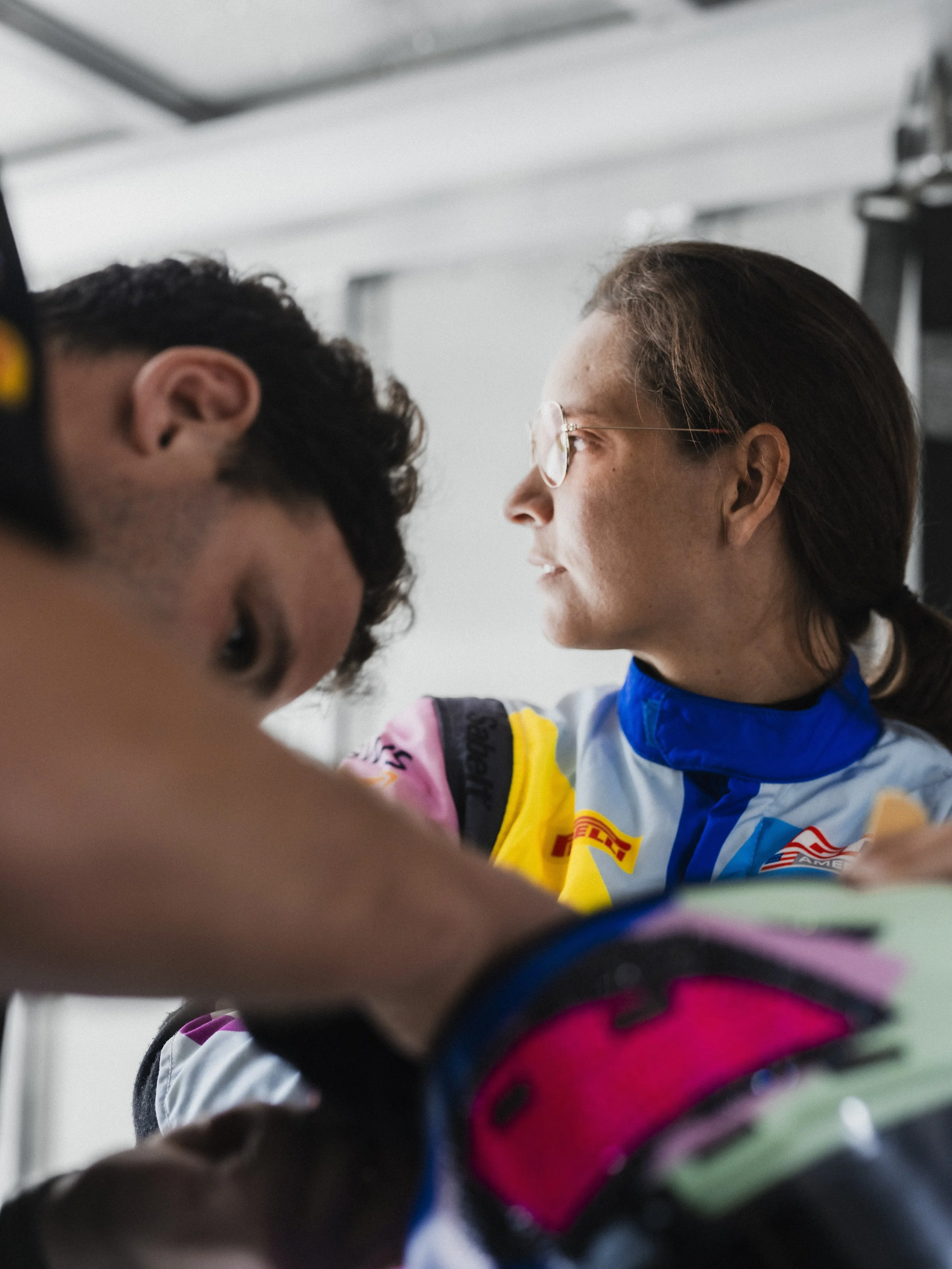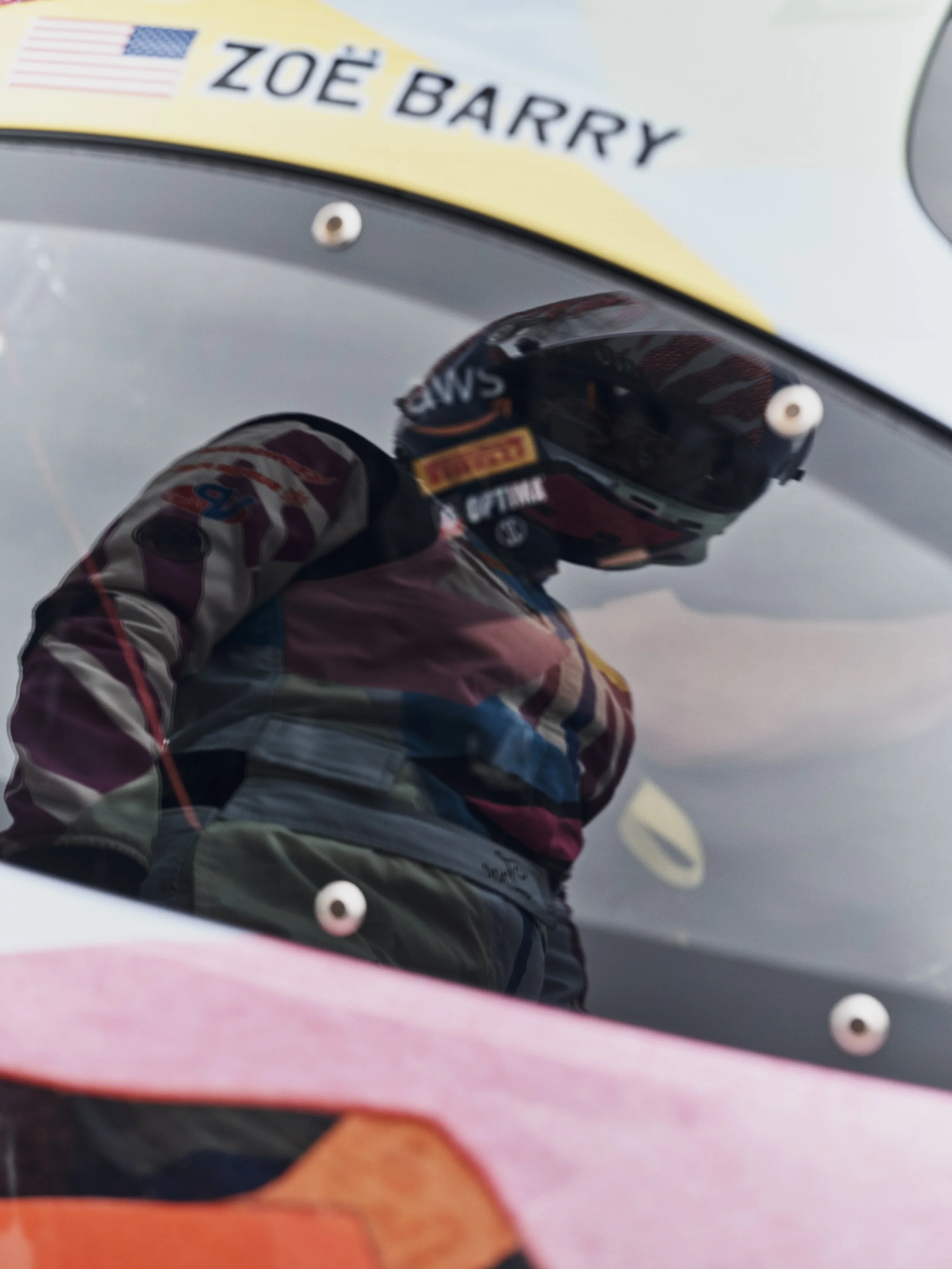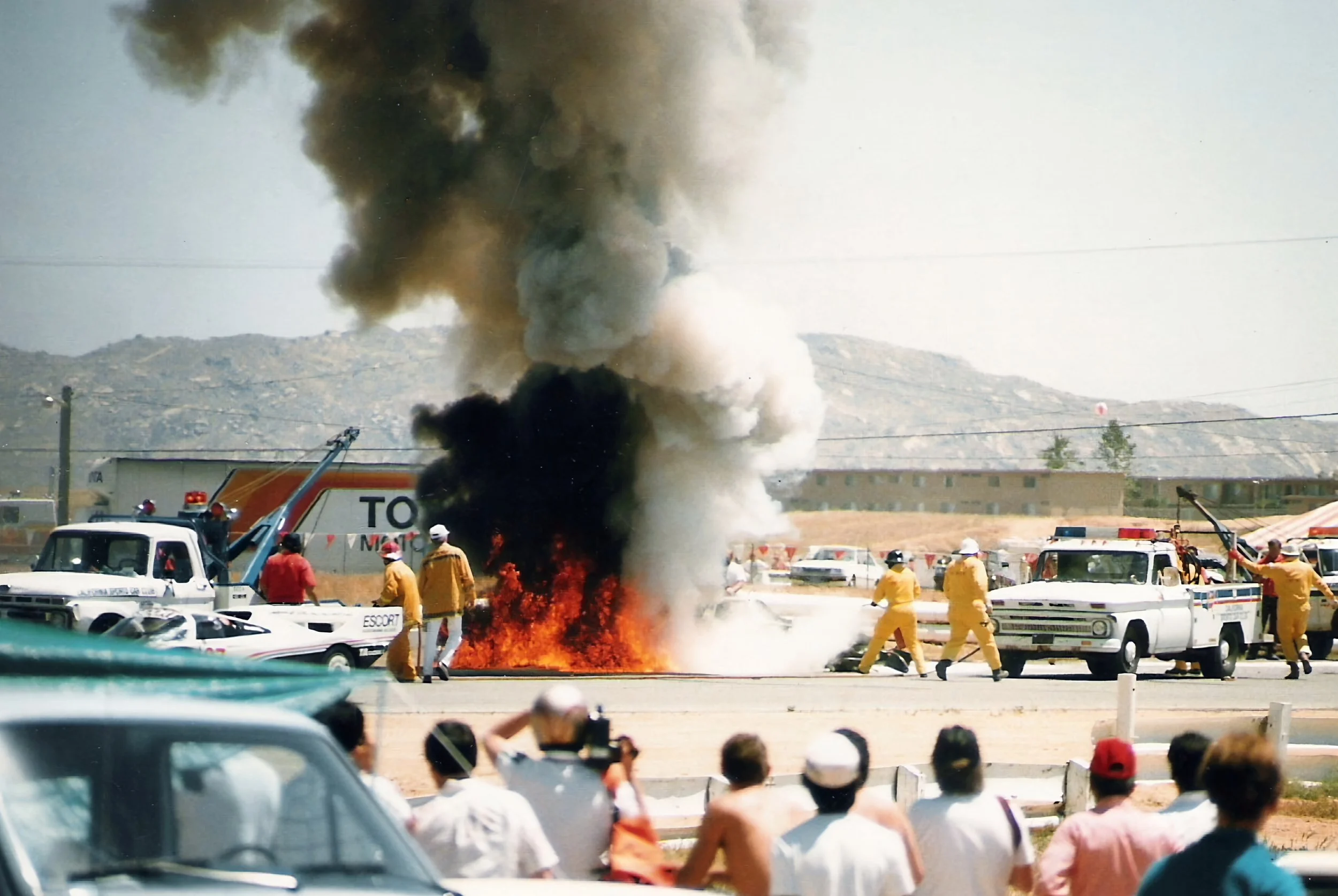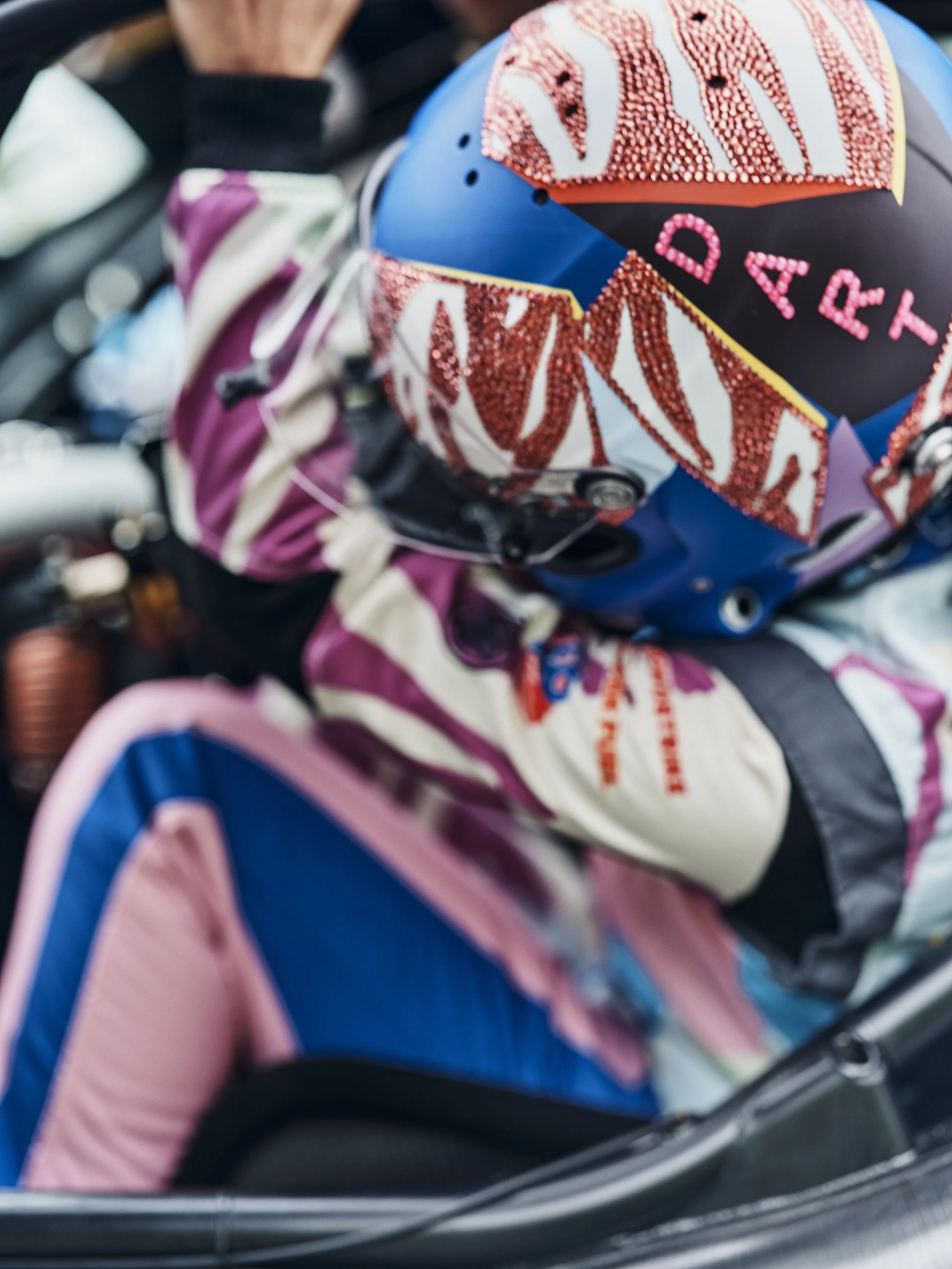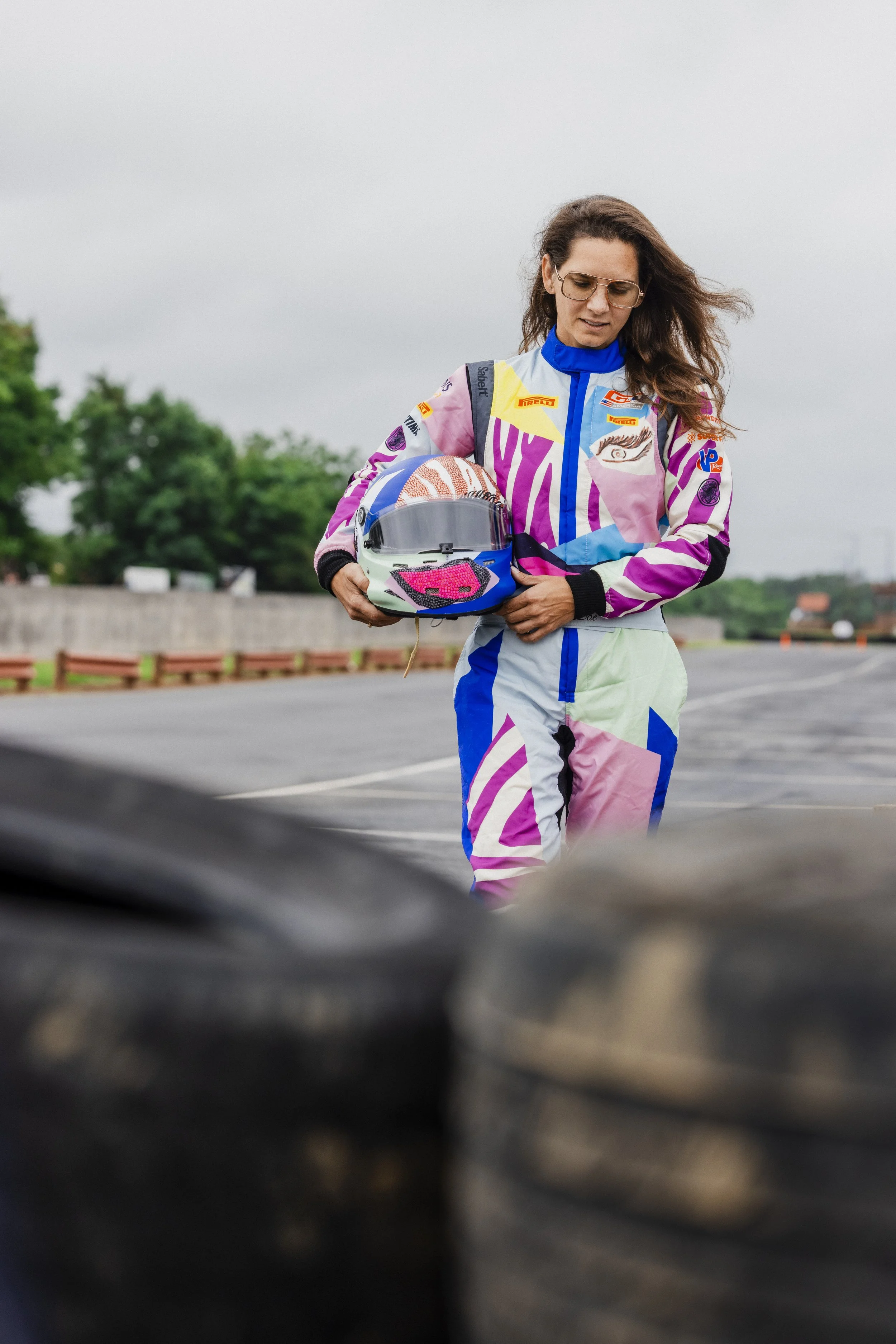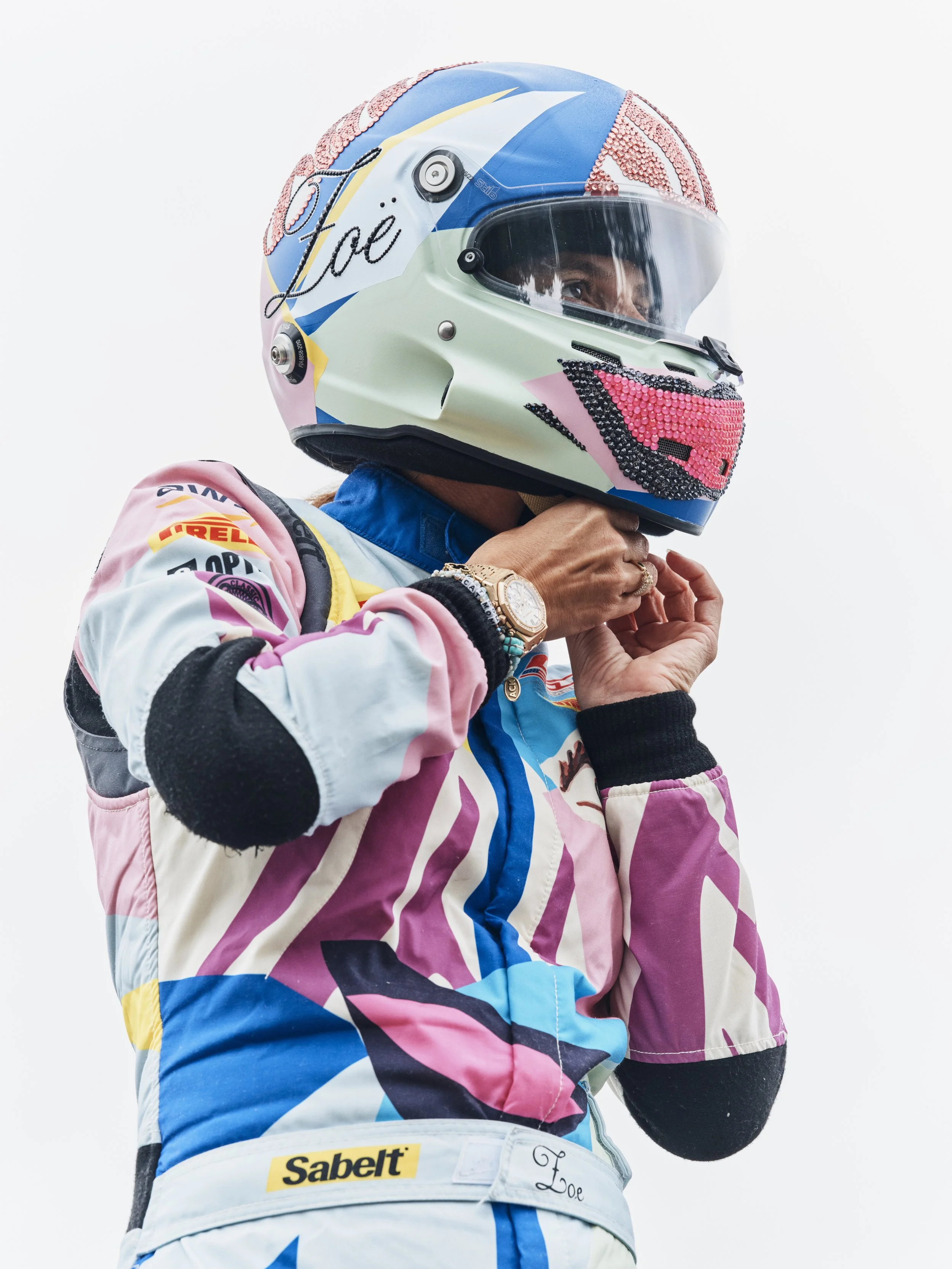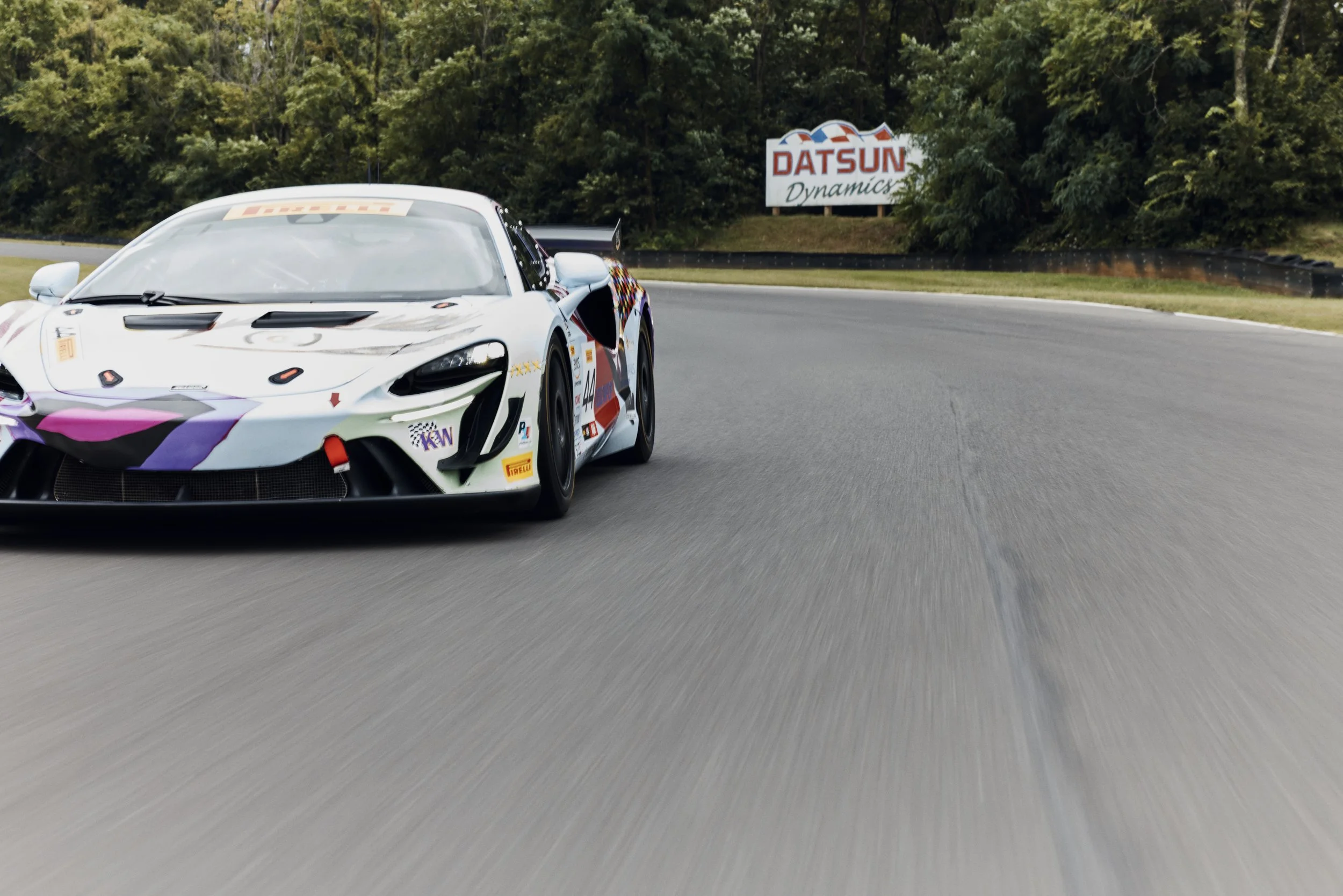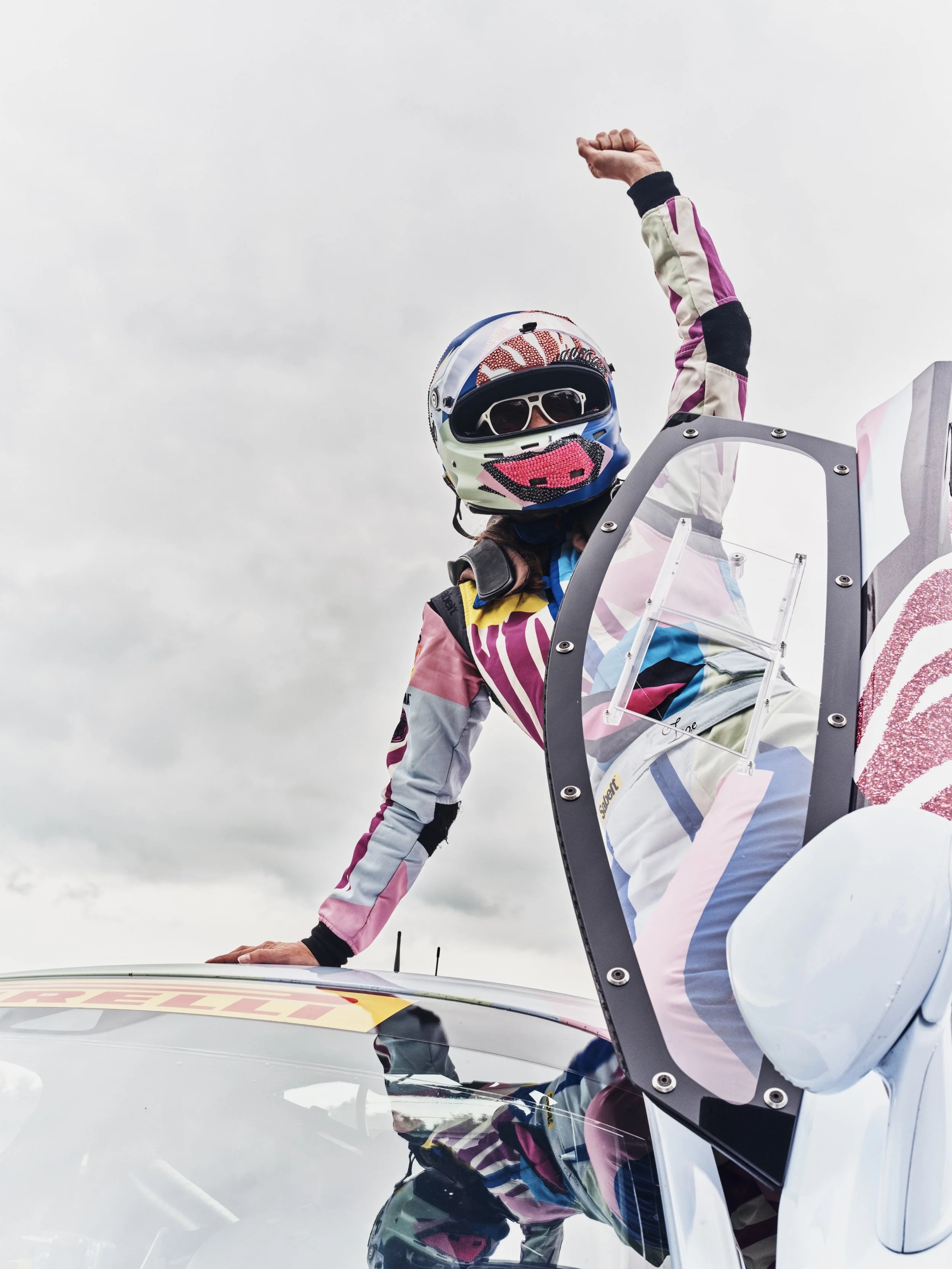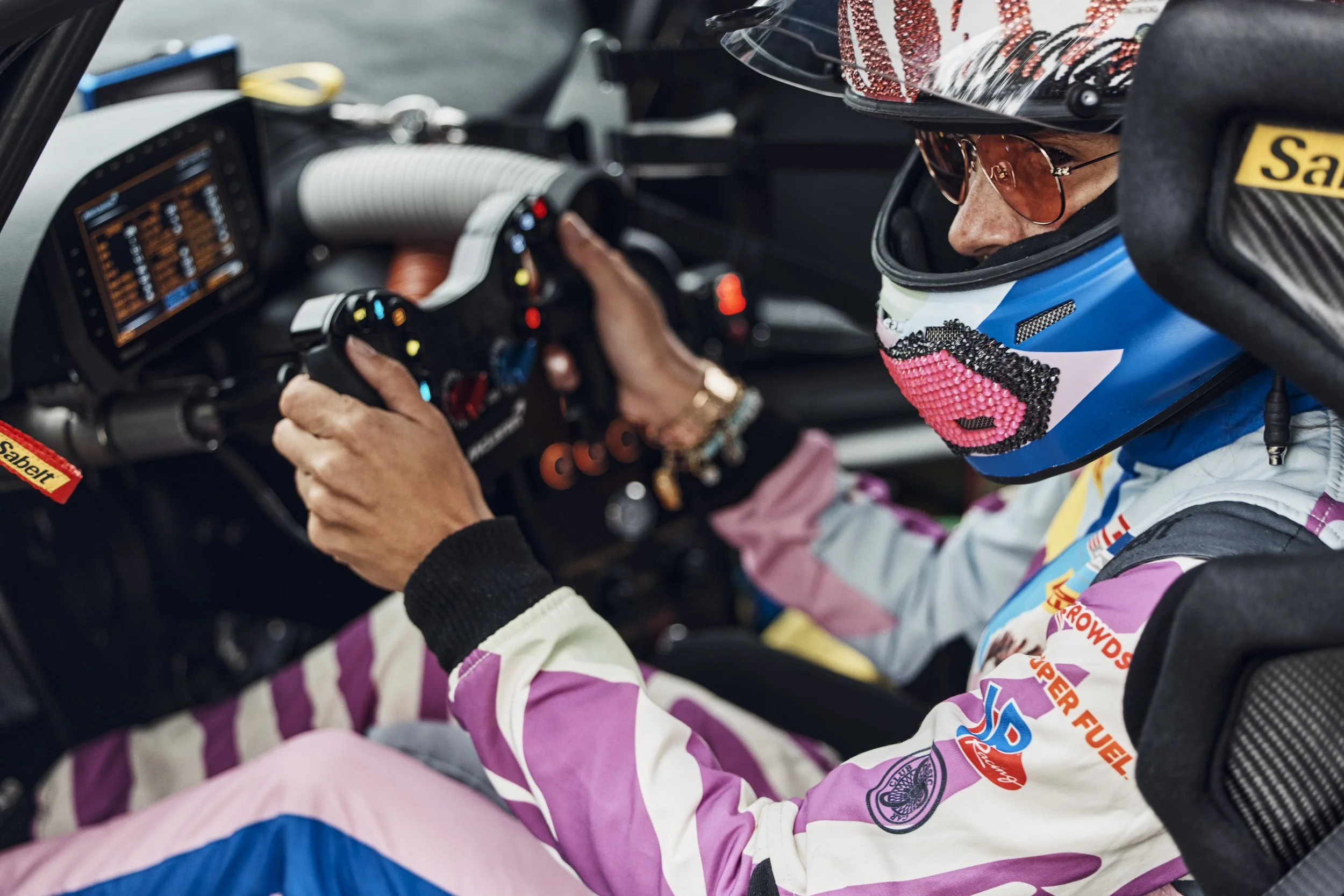In motorsports, where just 4% of drivers are women, Zoe Barry and Lyn St. James break down the stakes, strategy, and survival on the racetrack.
interview by Zoe Barry
photography by Amanda Demme
In one of the most dangerous and competitive sports in the world, Zoe Barry drives Car #44—a number that highlights the stark reality that only 4% of licensed professional racecar drivers are women, and only 4% of artworks sold at auction are by women. Behind the wheel of a McLaren Artura GT4, wrapped in a custom livery by contemporary artist Mickalene Thomas—who also designed the race suits and helmet—Barry focuses on one thing: winning. Yet in a world still dominated by male decision-making, from rivals on the track to corporate sponsors off it, she must confront stereotypes and misconceptions at every turn.
In 2025, she co-founded Driven Artists Racing Team (DART Car) with art advisor Spring McManus to champion women in motorsports and the arts—a first-of-its-kind initiative that fuses competition with creativity, proving that performance and cultural impact can drive change together. In January 2026, the team will compete in the 24H Series Middle East Trophy in Dubai and Abu Dhabi as the first all-female-led team in the series.
Lyn St. James, now a mentor in the field, is a living legend: the only woman to win an IMSA GT endurance race solo (1985 at Watkins Glen), the first woman to earn Indianapolis 500 Rookie of the Year (1992—a record unbroken for three decades), the holder of dozens of speed records, and the first woman to surpass 200 mph on a closed oval, reaching 204.233 mph at Talladega. Together with St. James, Barry explores the psychological and strategic challenges of racing—the constant risk of death on the track, the split-second decision-making, and the stamina and endurance required to outpace the competition.
In a special photo feature supported by Caddis Eye Appliances—a champion of second acts in life, reflecting Barry’s leap into racing after a career in the corporate world—we followed Car #44 onto a practice track in West Virginia, capturing the raw grit and glamour of a day in the life of a champion racecar driver.
ZOE BARRY: Lyn, of course, people can Google you, but hearing you speak on a panel brought out the heart, the challenges, the soul behind the story. It reminded me of Einstein’s quote about standing on the shoulders of giants. Women like me can get behind the wheel today thanks to women like you who took those early risks and broke the stereotypes. Even now, only about 4% of racecar drivers are women. Unlike Olympians, who often follow a clear path, female drivers are competing alongside men in a world that doesn’t want to fund them, doubts their ability, and fears they’ll get hurt.
LYN ST. JAMES: Every woman in racing right now is an iconic, isolated story unto herself. There are so many different forms of motorsport, and unlike Olympic athletes—where there’s a fairly cookie-cutter pathway to the top—there’s no single route to get there in racing. I’ve had the luxury, through the Women’s Sports Foundation, to meet icons like Billie Jean King, and I’ve crossed paths with incredible athletes like Diana Nyad, Nancy Hogshead-Makar, and so many others I grew up watching on TV. Their accomplishments are extraordinary, and I’m not at all taking away from their abilities, their talents, or what they’ve achieved. But there is a fairly clear pattern for how to get there in those sports. Whether it’s through coaches, training centers, or established pipelines, there’s an infrastructure that helps guide the way.
In motorsports, there is no such infrastructure. There’s drag racing, oval track racing, stock car racing, road courses—so many different forms of the sport. And on top of that, there’s an enormous amount of politics and money involved. It’s constantly shifting, and every driver has to figure out their own path through it. But every female driver has to constantly carve out a niche and prove they belong there. Even to this day, what I’ve accomplished doesn’t necessarily make it easier for the women coming up now. At best, it might inspire them, give them confidence, or encourage them to try. But beyond that, you still have to prove yourself.
BARRY: (laughs) I'm working on it, Lyn.
ST. JAMES: I’m still here to mentor, to be an ally, and to help however I can—but I can’t get in the car, make the calls, or close the deals. In racing, you have to wear so many hats: raise money, manage your team, and convince sponsors to believe in you. And that’s the part people rarely talk about. I once heard a brilliant woman in the UK describe how, in many ways, we’re still in the caveman era—men are inherently wired to protect women. It’s just a deeply ingrained instinct we’re still navigating.
ZOE BARRY: And you can see it in the data. Years ago, if you had a three-year-old daughter, you’d put her in ballet. Today, parents don’t hesitate to put their kids—boys or girls—on skis, on a tricycle, or on a bike. But with racing, it’s different. Very few parents think, I’ll put my three-year-old daughter in a kart and let her go. That’s still where racecar drivers come from, and we haven’t broken through that mindset in the way we have in so many other sports.
ST. JAMES: Exactly. And that’s where racecar drivers come from—starting young. Fortunately, history has helped. Title IX in the ’70s changed things. Now we have parents who went to college, saw women compete in sports, and understand that women can push themselves physically just as hard as men. That’s progress. But there are still limitations. My daughter is in her forties, and I have a seven-year-old granddaughter. Would she put her daughter in a kart? No. Would she put her son in one? Yes. So it’s still very much about individual decisions, shaped by these cultural assumptions. We can’t ignore those realities. I’ve literally sat across from male sponsors who couldn’t bring themselves to say, “We won’t give you money because you could get killed.” But I knew they were thinking it. So, I said it for them, “I know I could die doing this. I’ve seen death on the track. I made a conscious choice to accept that risk. It’s that important to me.” Every racecar driver—male or female—has to reconcile that risk. But for women, it’s another layer of resistance to push against.
BARRY: Lyn, one thing I’ve noticed in my journey raising money is how similar it is to your experience securing sponsorship for racing. In tech, as a female founder, only 2% of the billions deployed in venture capital each year go to women. It’s similar in sports: women drive huge sales—Nike sneakers, for example—but female athletes are paid far less, sometimes 90% less than men. In racing, it’s the same: women get a fraction of the sponsorship, so they have to do so much more.
When I was in tech, there’s something called Keyman Insurance. If the key person—often the CEO or founder—dies, the business faces risk because they’re a major shareholder and driver of innovation. When I started racing, my chairman raised concerns with our lead investor about Keyman Insurance, implying my racing was a liability. I shot back: statistically, racing is safer than skiing. Are male CEOs stopped from skiing? No. Sometimes you counter with data, sometimes you confront it directly. You have to be upfront: yes, I could die doing this, but I’m doing it anyway. All the way up to F1, I don’t hear drivers having to defend their choice to be in a racecar, going over 200 miles an hour with the real risk of death. In all the conversations I’ve had with top athletes in this space, men simply don’t have to answer that question.
ST. JAMES: They don’t have to answer that question. In fact, it actually makes them more heroic, because people admire them all the more. When Eric Anden died, our sport stopped—literally. Not just Formula One, but the entire motorsports world. The same happened when Dale Earnhardt was killed. These were icons we never expected to lose in a racecar, and their deaths reminded everyone of the risks involved.
Women drivers are just as courageous. When Catherine Leg crashed at Road America years ago in an IndyCar, she walked out of the medical center after a horrific crash. I had a similar experience at Riverside in 1986. I was upside down and on fire, yet I crawled out and walked away. But now, we’re not always admired for it. I remember someone at Ford, who was sponsoring me at the time, saying, “Oh my God, she really drives just like the guys. And she didn’t cry.” I thought, You’ve got to be kidding me.
BARRY: Let’s go back to the beginning. How did you get started, Lyn?
ST. JAMES: It started when I discovered endurance racing—a form of motorsport I didn’t even know existed. I went to the 24 Hours of Daytona with my husband as a spectator, and I was blown away. These cars raced for a full twenty-four hours, and as a fan you could actually see the people—the crews, the human effort—behind it all. I called it seeing “real people” instead of superheroes, the way IndyCar or Formula One often felt. I was fascinated by how drivers with Corvettes, Camaros, Mustangs, and other so-called “back-of-the-pack” cars still managed to compete. That’s when I learned you needed a competition license. To get one, you had to join a club—so I became a member of the Sports Car Club of America. Then I found out you also had to attend a driver’s school before you could earn that license.
BARRY: How old were you at the time?
ST. JAMES: Well, I went to driver’s school and became a member of the Sports Car Club of America (SCCA) at twenty-seven and got my license a few years later. To participate, you needed a racecar, and there was a new class called Showroom Stock. You could take a production-based car, install a roll bar, a five-point seatbelt, and a five-pound fire extinguisher, and you could race. I bought a four-cylinder Pinto, which became my first racecar.
I drove it back and forth to work during the week and raced it for a couple of seasons. Eventually, I won the regional championship with it. That was the beginning, and it lit a fire in me. Going over a hundred miles an hour—on the front straightaway at Palm Beach International Raceway with a tailwind—it was exhilarating. I’ve always been a sucker for challenges, and every moment in a racecar tests you—your technique, your reactions, the car, your competition. It throws challenges at you constantly, and I just soaked it all up. I loved it, and I’ve never stopped loving it. I’ve never looked back.
BARRY: How many years to get your professional license?
ST. JAMES: To race professionally, I needed an IMSA (International Motor Sports Association) license. That was necessary to race in the Kelly American Challenge Series. I actually raced my husband’s Corvette at Daytona—not in the 24 Hours, but in one of the other events they held there. To get the IMSA license, you needed enough races under your belt, and you had to go through the licensing process, which is good—you really have to learn it. (laughs) Within a couple of years, I earned my professional license and I started racing in the Kelly American Challenge Series, which was a support race at IMSA events. They even offered a bonus prize for the top-finishing female driver in each race.
BARRY: That’s pretty progressive. They barely do top female finisher now.
ST. JAMES: Yeah, Kelly really needed to do something to support women in racing because of their history of primarily employing women as temporary secretaries, even as they expanded into light industrial work. I raced in all ten races in 1979—and I won in every race. That started to put me on the map because the race results were published in Speed Sport News, which didn’t have as wide a reach as today, but it mattered. They always noted the top female driver in the results, which helped get my name out.
Through that exposure, I was invited to race in the 24 Hours of Nürburgring as part of the BF Goodrich factory program, and we won our class. Around that time, I also started a company called Creative Images and used it to write sponsorship letters. I couldn’t sign my own name because it was promoting “Lyn St. James,” so I made up names of people in my company to make it seem bigger than it was. (laughs) One of the companies I targeted was Ford Motor Company. I’d seen a 1978 Car and Driver article titled “Ford and Feminism,” highlighting the company’s efforts to provide equal employment opportunities for women in non-traditional roles. I bombarded them with letters every time I raced and sent my results, relentlessly following up. In 1981, it paid off—I signed with Ford and became a factory driver. That was the tipping point in my career, the moment everything started to change.
BARRY: I’ve always been a daredevil—growing up in NYC, I was constantly taking risks, from gymnastics on rooftops to catching animals with my bare hands. I competed nationally in gymnastics, swimming, and sailing, but injuries and physical limits held me back. Then I discovered racecar driving—a sport where you can compete at a high level for decades. My first car was a racecar; I traded equity in my tech startup for a Mazda to start racing seriously. I went through racing school, club races, and learned the grind of back and mid-pack racing—the chaos, the carnage, and the challenge of getting to the front.
At forty, I earned my professional license. I applied a venture model to my racing team: raised funds, bought a GT4, and collaborated with artist Mickalene Thomas, who designed hand-painted helmets and suits. In our first pro race, we finished fourth. Now, my goal is historic: to run the 24H Series Middle East Trophy with an all-female team—a first for that race. For me, as an athlete, everything I did in gymnastics and swimming was sprint-focused. A gymnastics routine is only four minutes long. Swimming, of course, was pure sprint. In racing, our sprint events started with Mazdas in club racing—about twenty minutes long, but extremely fast. What were your early sprint races like?
LYN ST. JAMES: My early amateur races were about thirty minutes. In pro racing, sprints usually run forty-five minutes to an hour—single driver, no pit stops. You have to manage fuel and tires carefully, because a car can only go so far before running out or wearing down. Safety and refueling rigs are factors too. For example, in the TransAm series, races were an hour with no pit stops, so the car had to be built to last the full distance.
Endurance racing is a different beast. The crew becomes the most important part—not the drivers. We’re just the machines in the car, responsible for staying out of trouble, driving fast, and bringing the car home intact. The crew keeps the car running, handling refueling, tire changes, brake maintenance—sometimes nonstop for 24 hours. You learn exactly what every person on your crew—and your competition—is made of, because anything can happen. Plans go out the window, and it’s all about how people respond under pressure.
BARRY: People don’t usually think of the car as an athlete, but you should. In endurance racing, that becomes clear. You have to prep the car differently for a sprint, a driver change, or a 24-hour, long-haul race. The approach for a true long-haul endurance event is completely different.
ST. JAMES: Absolutely. Without a crew who understands the nuances, you’re in trouble. Every component—brakes, suspension, setup—has to be prepared differently for an endurance race versus a sprint.
BARRY: I haven’t done a full 24-hour race yet, but there’s so much that goes into it from a planning and logistics standpoint. In many ways, it reminds me of tech—using a Gantt chart or burn-down chart to map everything out. If your goal is to launch on a specific date, you need to identify all the pieces that must be in place beforehand. Then you have a fixed budget, and you have to decide where to allocate resources and which areas deserve the most focus.
ST. JAMES: This is an organic response, but I really like that you have a singular, unique goal. Not only is it an endurance race, it’s in Dubai—a location where not much racing happens outside of Formula One. And doing it with an all-female driver lineup adds another layer of significance. Ideally, you’d integrate some women into the crew as well, though having an entirely female team can be extremely challenging given the skill and experience required.
I highly recommend, before attempting this, that you get some endurance racing experience under your belt. One series that comes to mind is the WRL (World Racing League), which features six and eight-hour races. It didn’t exist when I was racing, but from what I understand, seats aren’t prohibitively expensive or hard to get. Participating in one of these races as part of a driver lineup would give you a chance to observe, understand, and truly experience what endurance racing demands.
BARRY: Oh, they have one coming up at Watkins Glen! The “blue bush.” (laughs) Just so people reading this know, Watkins Glen has almost no runoff space—just a narrow strip of grass, maybe two car widths, before you hit the guardrail. To make it feel less scary, they’ve painted the guardrails blue—but any mistake, and you hit the grass, then the “blue bush.” The cars are all banged up.
ST. JAMES: I love that track. I made history there. I was racing for Ford in a Mustang in the Serengeti 500, a 500-kilometer endurance race in the GTO division of what was then called the Camel GT series. That season, I ended up with a different co-driver almost every race. For this one, I had a replacement co-driver I knew was competent—but honestly I was in the groove completely, so I wasn’t thinking things through. When I came in for the scheduled pit stop—where we were supposed to change drivers, refuel, and swap tires—I didn’t get out of the car. I didn’t put the window net down; I just shook my head “no.” In a pit stop, you only have 30 seconds, so there’s no time for discussion. The team, my co-driver, and the managers exchanged glances as I stayed in the car. They changed the tires, fueled the car, and I took off, running the entire race myself—and won the GTO division.
No other single driver, male or female, had ever won an endurance race solo. Since then, the rules have been changed so no driver can do it alone. That victory came with a few funny and frustrating moments. At the podium, I was alone—no car, no co-driver, no crew. The trophy was handed to me by a Serengeti representative, a guy from their retail team, which was both hilarious and surreal. Later, when I returned to the garage, the car and crew were gone. They took me out of the next race, so I missed the points. I ended up paying a penalty from my team for making that split-second decision. It’s a moment in my career that brings me a lot of excitement and pride, but it’s also a reminder that when you don’t play by the rules, there are consequences.
BARRY: What do you think are the different qualifications that go into being a good racecar driver? For me, you need basic skills—hands-on feel for the car, quick reflexes, eyes up to anticipate what’s coming. Over time, you learn to anticipate crashes or mistakes, even guide someone off the track without touching them. For example, at Sebring, my home track, I know a turn where the correct line is left. If someone dives inside, they might hit a greasy spot and go off—totally legal, not my fault.
It also requires an appetite for risk. When you sign up for this sport, you know you might die. Most sports don’t ask that—basketball, swimming, gymnastics—you aren’t thinking, I could die today. High-performance sailboat racing is closer, but in racing, it’s constant. From there, it’s awareness—reading competitors, understanding how they’ll react. Then it’s emotional intelligence, knowing how to push someone without endangering yourself. And finally, it’s about the fear factor—can you manage it, or do you let it manage you?
ST. JAMES: I think you just have to have really good perception and vision. Not only good reaction time, but anticipatory reaction time. You have to be able to anticipate and definitely have a feel for the car. Whether it’s through your body completely—I mean, your feet, your butt, your hands—I mean, all of that. You really wear the car. You become one with the car. I call it desire. You have to have a hunger for outracing and outmaneuvering.
BARRY: When you level up—in a new car, a new series, or a higher league—you get picked on. You just have to accept it as part of the process. I feel like all I’ve been doing is crashing—not in racecar driving necessarily, but in every sport. In gymnastics, everything is about falling. In tech, there’s the saying, “fail fast.” In sailing, on your first day in a boat, all you do is find the edge. It’s a full day of learning how to capsize the boat, pulling yourself out of the water, getting wet, draining the boat, and sailing forward. Then the coach blows the whistle, and you capsize again.
For me, I’ve totaled several racecars—on average, probably every other year. You don’t want to, but it’s part of leveling up. Going from Mazda to Porsche is a huge jump in speed and cornering. Competition also gets more aggressive as you move from club to national to pro racing, so there’s a steep learning curve. You’re the greenest person on the track, and people take advantage of that. In sailing, we used to call it “finding the marshmallow.”
ST. JAMES: First of all, it’s an expensive sport. I’ve had some older competitors say that women can drive racecars, but the reason they’re not more successful is because they don’t want to hurt the car. Try having that conversation. (laughs) The idea being that women are mothers and are “meant to protect everything in the world.” But there’s always a risk–reward in every move you make. Over time, you learn that you can’t build a career if you’re known as a crasher. Fortunately, I didn’t crash a lot, but I was still worried about it. Whether it’s crashing or being too hard on the car, you can’t afford that reputation.
One piece of advice I always try to share—whether with other female drivers or anyone I mentor—is that the best drivers never ask more from the car than it’s willing to give. If you overdrive, eventually you’re going to crash or break the car. And if you do that often enough, people won’t want you in their car. To build a career, you need to be both available and desirable as a driver. If you’re known for wrecking cars, there’s always going to be someone else waiting with a helmet who doesn’t carry that reputation.
BARRY: At the second race in Sonoma, we didn’t run because it was a rain race. And I love the rain. That’s my time to shine. It’s my absolute favorite condition to drive in. My coach always says I’m a beast in the wet. (laughs) But they canceled. In the GT3 race, I want to say they lost about a third of the field—badly. Then, they had the McLaren Trophy, which also got cancelled because so many cars were destroyed or driven off track. It was nuts—torrential rain. So, by the time our race came around, a lot of us decided not to go out.
We had to make a decision—because we were running a Mickalene Thomas car, which is a multimillion-dollar car. Everyone else out there is in a $250,000 to $300,000 car. I’m in something worth $2 to $3 million. I’m not going to take that risk. I can be really aggressive with my driving at the right time. When I drove the Mickalene Thomas car, I went from the back of the pack to fourth place. I have that data. But there are also times when you have to say, “I can’t take a 25% chance of putting this car into a wall.” Or, even if I don’t make the mistake, if someone else hits me, or the track is statistically likely to send you off—then you weigh the risk differently.
ST. JAMES: Every opportunity is an opportunity to make a decision. You assess the situation and try to make the best call. Now, if you’re always going to raise your own money, run your own team, and drive your own cars—fine, do whatever you want. But if you want a career as a professional driver, you can’t be known as a crasher.
BARRY: One thing we haven’t talked about too deeply is the Mickalene Thomas art aspect of DART Car. I’m really proud of this part. I raised investor dollars and made sure part of that funding went directly to Mickalene for this work. We gave her full creative license and she delivered a bold, Cubist-inspired design with lips on the front and a winking eye motif.
That visual language carried through everything—the car, the helmets, the race suits, all with those lips. Mickalene jokes they’re “for all the kisses in all the special places.” It’s playful, but it resonates. People love it. And not just women—men too. You’d expect women to gravitate toward hot pink and crystals, but when the car was being wrapped in a private garage, collectors kept coming through asking for photos. And it wasn’t just collectors. When we went to the tech inspection, the crew—not museum-goers or gallery regulars—were holding the helmet like it was a treasure. At that time, none of us knew how the market would respond, but then my first helmet sold at auction at Silverstone, during the F1 event in July, for $150,000. Since then, collectors have been snapping up DART pieces, and that’s the mission: every sale funds more driving, gets more women behind the wheel, and raises visibility for female artists.
ST. JAMES: Sometimes that’s one of the unique roles women can play in this competitive world—where certain lines of demarcation get blurred. Women can bring a different lens, elevate the story, and shift the narrative. This is one of those examples.


